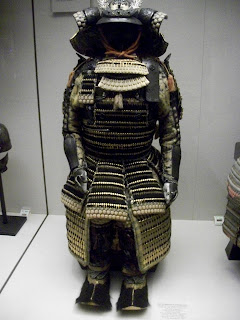


When we had the discussion in class what the difference was between arts versus artifacts I was not entirely sure. Artifacts always seemed to cross over into the arts for these people had a skill that was a type of art. But when we were told to enter the museum (the V&A) and carefully study all of the textiles put on display that represent history throughout many different periods and cultures I started to study the names of the artists meant to be on the plaques besides these preserved artifacts and to my dismay did not see any. It is a large topic of debate with many worthy opinions: are these preserved objects in museums such as suits of Armor that the Samurais wore Art or Artifacts? And after truly observing and studying how these objects are displayed in museums I cannot see them as art anymore but only as artifacts. They are not meant to represent a group of artists or even a specific trade or craft but an entire culture and period of time. The artist is not even mentioned and most likely not known. I noticed that the process of the artifact being made is not mentioned either. It is funny to think that in 100-200 years they will put our clothing on display in museums. Our soldiers’ uniforms may be on a manikin behind a class case. We would never call our present soldiers’ uniforms art. Even uniforms put on display in army and science museums that are from World War 2 are not considered art. They are without argument artifacts. And to think that these uniforms would represent our whole period of time and culture would not be accurate either. However if a Prada were in a museum it would be considered art, it would give that individual brand credit. I think it is reasonable to say that the armor created for the Samurais in Japan may be considered a craft. For it took a lot of skill and craft to make these beautiful artifacts. Not only do we have to consider skill but tradition as well.
Kimonos were never viewed as an art for they were made by a group of people rather than an individual. But a man whose name has escaped my mind spent many years in prison in Japan and when he was released he began creating kimonos with his bare two hands, as an individual. He hand dyed and embroidered each kimono with the setting and rising sunsets that kept him alive while imprisoned. This man’s kimonos were considered art and displayed in galleries. People rarely want to see art as a product made by a group of people or even by a factory, but a product created by an individual made by hand.
I have concluded that an artifact is not about the people who made them but the people who wore and used them. If a Balenciaga dress was displayed in a museum, the plaque would not discuss the culture or go into great depth of the era but it would give Balenciaga recognition; it would represent his dress as a piece of art and him as the artist. However textiles and dresses from the Victorian era are represented as an artifact meant to give people in the present a sense and vision of people in the past. So things have changed. In the past mothers passed their craft and skill on to their daughters. It was not looked at as an art form but as a form of tradition. Embroidering was not considered a form of art but a desirable decorative skill. In present times however, art is about an individual’s uniqueness that they are very skeptical about sharing with other people. Artists have become very secretive and possessive about their work which has brought about copyright laws. And buyers have become very concerned with brands and names of artists. Even if Mercedes comes out with a cheaply made and affordable car, it doesn’t matter that Toyota makes a better quality; people will still want to buy the Mercedes in order to have that brand. We have to acknowledge how this argument has become a complicated debate because culture has changed how our mind sets have changed.


